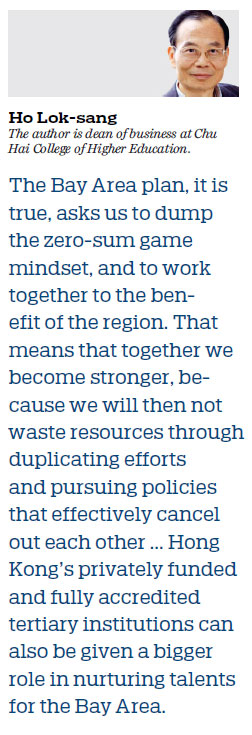Bay Area an example of market-driven planning
Updated: 2019-02-20 07:11
(HK Edition)
|
|||||||
Ho Lok-sang says the plan offers great opportunities to businesses, entrepreneurs and individuals and HK universities are also well positioned to contribute to it
'Market-driven planning" appears to be a contradiction in terms. But that is what it is. The Guangdong-Hong Kong-Macao Greater Bay Area plan as announced on Monday actually respects the comparative advantages of the different cities, and promises to provide infrastructure and planning support to further reinforce these comparative advantages.
For example, according to the blueprint, Hong Kong is to serve as an international financial, shipping, and trade center as well as a global aviation hub within the Bay Area. Hong Kong is also to serve as the international arbitration center in the Asia-Pacific region. But that is what Hong Kong is today. Similarly, Macao is to be a world-class tourist destination and leisure center, as well as a commerce and trade cooperation service platform between China and Portuguese-speaking countries. Again that is what Macao is best at.

One might then ask: If the roles "assigned" to each of the 11 cities in the Bay Area are what each of them is already doing or trying to do, then what good is the plan? The answer lies in the need for policy coordination, for infrastructure planning, and for promotion purposes. Yes, in order to advance on the fronts that have already been identified by the market, the governments of the different cities, as well as other levels of governments, have to put their acts together. For example, in order to advance Hong Kong's role as an international financial center, policy has to be in place so the scale and scope for cross-jurisdiction use of the RMB will be increased, various derivative financial products will need to be introduced, and enterprises in the Bay Area should have greater leeway to issue RMB-denominated bonds. If Hong Kong is to serve as a conduit for infrastructure and investment financing along the Belt and Road, policies will also have to be in place to make this not only possible, but also easy for all stakeholders. Hong Kong has also been identified as well positioned to fund investment in the Bay Area using private equity funds. Again policy has to be in place to make this possible.
For this reason, the Bay Area plan offers tremendous opportunities to businesses, entrepreneurs, and individuals. I was involved with the RTHK Backchat program not too long ago discussing Hong Kong's No 1 ranking in the Heritage Foundation's Economic Freedom Index. A question came up over whether the inclusion of Hong Kong in the Bay Area plan represents a departure from markets and an erosion of economic freedom. My answer was a resounding no. The Bay Area plan will not force any business or anyone to do anything other than what that business or that one person wants to do. Instead, because of the new policies and better infrastructure in place, businesses and individuals have more opportunities and more freedom!
Another concern was expressed by Chairman of the Democratic Party Wu Chi-wai. He says whether the Bay Area plan will be to Hong Kong's advantage "depends on the mentality of the SAR government and its strategic positioning". He said that if all the mainland cities take their self-interest as priority, while the SAR government simply tries to accommodate the requests from other cities instead of competing with them, then Hong Kong could lose out. In particular, the SAR could suffer a brain drain if our talents migrate elsewhere. A similar concern came from the leader of the Civic Party Alvin Yeung Ngok-kiu. He says that the integration of the cities in the Bay Area implies more intense competition for talents and resources. Instead of simply cheering the Bay Area plan, he says, the SAR government should work out a credible policy to retain our talents.
Yeung is right in saying that Hong Kong needs to do much more to attract and retain talents. He is also right in saying that the competition for talents is intense. The question for us is, however, whether we should accept the challenge and compete with the rest of the world for the best talents, or whether we should close the door and shun the competition.
I personally do not worry about the brain drain. If we do experience a brain drain, it means that we are not doing things right. Given that we are a world-class, internationally well-connected city, and blessed with fine institutions, low tax rates, and greater infrastructure, we should just work together to ensure that our society is stable, safe, and liveable, rather than fearing the competition. The Bay Area plan, it is true, asks us to dump the zero-sum game mindset, and to work together to the benefit of the region. That means that together we become stronger, because we will then not waste resources through duplicating efforts and pursuing policies that effectively cancel out each other.
One central theme that comes across from the Bay Area plan is that the 11 cities should work together to become globally competitive through technology-driven innovations. In this regard, Hong Kong's universities are well placed to contribute to the effort. Hong Kong's privately funded and fully accredited tertiary institutions can also be given a bigger role in nurturing talents for the Bay Area.
(HK Edition 02/20/2019 page8)